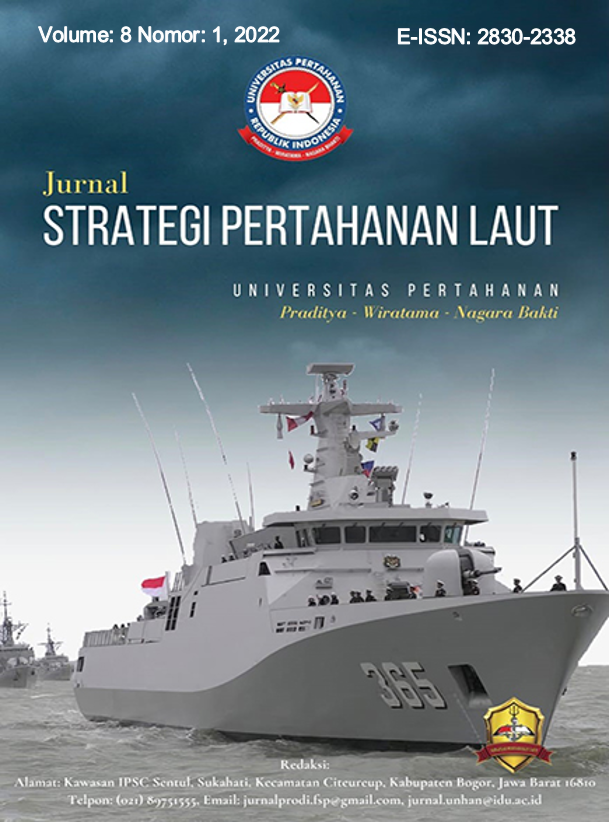STRATEGY OF INDONESIA MARITIME DEFENSE IN THE MIDDLE OF ASIA PACIFIC CONFLICT POTENTIAL IMPLICATION OF AUKUS (AUSTRALIA, UNITED KINGDOM, AND UNITED STATES OF AMERICA) VS PEOPLE'S REPUBLIC OF CHINA
DOI:
https://doi.org/10.33172/spl.v8i1.1040Abstract
Indonesia is a country located in the Asia Pacific Region which geography located in Southeast Asia and bordering direct with People's Republic of China and Australia. With position geographical this , defense strategy Indonesian seas , namely the World Maritime Axis, must noticed return see that People's Republic of China has To do initiation in reach his ambition To use reach hegemony in the Asia Pacific Region through claim nine dash line until formation Belt Road Initiative (BRI) with use silk road. In response Thing here , United States of America with Australia and England then shape alliance defense and security with ensure security of the Asia Pacific Region which then increase tendency conflict in the region. For see defense strategy sea , research this use maritime strategy theory and theory strength sea for see Indonesian capabilities . Study this use method qualitative in composing research . Result of study this namely Indonesia must consider return of the World Maritime Axis as a defense strategy sea see that development territorial water activities in the Asia Pacific Region increase accompanied with tendency increasing conflict _ tall Among People's Republic of China and AUKUS.References
Bamboo Cyberschool. (2019, January 16). The Geographical Location of China, the Land of the Bamboo Curtain . Retrieved from Bamboo Cyberschool: https://www.bamboocyberschool.com/post/letak-geografis-negeri-china-negeri-tirai-bambu-2
Belt and Road Initiative. (2021, November 19). Belt and Road Initiative . Retrieved from Belt and Road Initiative: https://www.beltroad-initiative.com/belt-and-road/Brooke-Holland, L., Curtis, J., & Mills, C. (2021). The Aukus Agreement. London: House of Commons Library.
Corbett, JS (2004). Principles of Maritime Strategy. New York: Dover Publications.
Gao, Z., & Ja, BB (2013). Nine Dash Line in the South China Sea: History, Status, and Implications. American Society of International Law , 98-124.
Indonesian Ministry of Foreign Affairs. (2021, September 17). Statement on Australia's Nuclear-powered Submarines Program . Retrieved from the Indonesian Ministry of Foreign Affairs: https://kemlu.go.id/portal/en/read/2937/siaran_pers/statement-on-australias-nuclear-powered-submarines-program
Magdalene, JV (2021, January 6). Implications of China's Belt and Road Initiative on the Economic Balance . Retrieved from LIA Center for Regional Studies: http://psdr.lipi.go.id/news-and-events/opinions/implication-belt-and-road-initiative-tiongkok-terhadap-neraca-perekonomian-indonesia.html
Mahan, AT (1890). The Influence of Sea Power Upon History. Boston: Little, Brown, and Company.
OECD. (2018). China's Belt and Road Initiative in the Global Trade, Investment, and Finance Landscape. Paris: OECD Business and Finance.
Parliament of Australia. (2018). Maritime Strategy Concept. Canberra: Parliament of Australia.
Prime Minister of Australia. (2021). Australia To Pursue Nuclear Powered Submarines Through New Trilateral Enhanced Security Partnership. Canberra: Australian Government.
Sakamoto, S. (2021). Historic Waters and Rights Revisited: UNCLOS and Beyond? Kyoto: Doshisha University.
Australian Sea Power Center. (2013). What is a Maritime Strategy? Canberra: Sea Power Center Australia.Supriyanto, RA (2016). Developing Indonesia's Maritime Strategy under President Jokowi. Seoul: The Asan Forum.
Suwanti, & Suharto. (2020, October 24). Several non-claimant states reject China's claim in South China Sea . Retrieved from Antaranews.com: https://en.antaranews.com/news/159725/several-non-claimant-states- reject-chinas-claim-in-south-china-sea
Thao, NH, & Amer, R. (2012). A New Legal Arrangement for the South China Sea. Ocean Development International , 333-334.
Thayer, CA (2016, November 14). The Southeast Asia Claimant States, ASEAN and the South China Sea . Retrieved from Maritime Issues: http://www.maritimeissues.com/politics/the-southeast-asia-claimant-states-asean-and-the-south-china-sea-dispute.html
United States of America. (2021). Joint Leaders Statement on AUKUS. Washington DC: White House Government.
University of Birmingham. (2015). Learn from the Sea Power Theory and Geopolitical Theory. Birmingham: University of Birmingham.
Wang, Z. (2015). Chinese Discourse on the "Nine-Dashed Line": Rights, Interests, and Nationalism. Asian Survey , 502-524.
Downloads
Published
How to Cite
Issue
Section
License
Proposed Policy for Journals That Offer Open Access. Authors who publish with this journal agree to the following terms:
- Authors retain copyright and grant the journal right of first publication with the work simultaneously licensed under a Creative Commons Attribution License that allows others to share the work with an acknowledgment of the work's authorship and initial publication in this journal.
- Authors are able to enter into separate, additional contractual arrangements for the non-exclusive distribution of the journal's published version of the work (e.g., post it to an institutional repository or publish it in a book), with an acknowledgment of its initial publication in this journal.
- Authors are permitted and encouraged to post their work online (e.g., in institutional repositories or on their website) prior to and during the submission process, as it can lead to productive exchanges, as well as earlier and greater citation of published work (See The Effect of Open Access).
Proposed Policy for Journals That Offer Delayed Open Access. Authors who publish with this journal agree to the following terms:
- Authors retain copyright and grant the journal right of first publication, with the work [SPECIFY PERIOD OF TIME] after publication simultaneously licensed under a Creative Commons Attribution License that allows others to share the work with an acknowledgment of the work's authorship and initial publication in this journal.
- Authors are able to enter into separate, additional contractual arrangements for the non-exclusive distribution of the journal's published version of the work (e.g., post it to an institutional repository or publish it in a book), with an acknowledgment of its initial publication in this journal.
Authors are permitted and encouraged to post their work online (e.g., in institutional repositories or on their website) prior to and during the submission process, as it can lead to productive exchanges, as well as earlier and greater citation of published work (See The Effect of Open Access)

